CALCUL AND PLOT ALTI DIAGS
[1]:
import numpy as N
import xarray as xr
import pandas as pd
import matplotlib.pyplot as plt
import matplotlib.dates as mdates
import dask
from os import path
from dask.distributed import Client, LocalCluster, progress
import time
import dask_hpcconfig
import glob
from scipy import signal
from dask_jobqueue import PBSCluster
from tools_alti import *
import cartopy.io.shapereader as shpreader
import shapely.vectorized
import geopandas as gpd
from matplotlib.ticker import MaxNLocator
WARNING:root:Setting cartopy.config["pre_existing_data_dir"] to /home1/datahome/mcaillau/conda-env/pydask3/share/cartopy. Don't worry, this is probably intended behaviour to avoid failing downloads of geological data behind a firewall.
USE PBSCLUSTER TO SET DASK SERVER
[2]:
#HPCONFIG
#cluster = dask_hpcconfig.cluster("datarmor-local")
#overrides = {"cluster.n_workers": 10,"cluster.threads_per_worker":1}
#cluster = dask_hpcconfig.cluster("datarmor-local",**overrides)
#PBS
cluster = PBSCluster(processes=4,cores=4)
cluster.scale(jobs=4)
#cluster=dask_hpcconfig.cluster('datarmor')
print(cluster)
/home1/datahome/mcaillau/conda-env/pydask3/lib/python3.10/site-packages/dask_jobqueue/core.py:255: FutureWarning: job_extra has been renamed to job_extra_directives. You are still using it (even if only set to []; please also check config files). If you did not set job_extra_directives yet, job_extra will be respected for now, but it will be removed in a future release. If you already set job_extra_directives, job_extra is ignored and you can remove it.
warnings.warn(warn, FutureWarning)
/home1/datahome/mcaillau/conda-env/pydask3/lib/python3.10/site-packages/dask_jobqueue/pbs.py:82: FutureWarning: project has been renamed to account as this kwarg was used wit -A option. You are still using it (please also check config files). If you did not set account yet, project will be respected for now, but it will be removed in a future release. If you already set account, project is ignored and you can remove it.
warnings.warn(warn, FutureWarning)
INFO:distributed.scheduler:State start
INFO:distributed.scheduler: Scheduler at: tcp://10.148.0.156:35948
INFO:distributed.scheduler: dashboard at: 10.148.0.156:8787
PBSCluster(f8325824, 'tcp://10.148.0.156:35948', workers=0, threads=0, memory=0 B)
CONNECT TO THE CLUSTER
dashboards https://datarmor-jupyterhub.ifremer.fr/user/mcaillau/proxy/127.0.0.1:8787
[3]:
# explicitly connect to the cluster we just created
print(cluster)
print(cluster.dashboard_link)
client = Client(cluster)
print(client)
/home1/datahome/mcaillau/conda-env/pydask3/lib/python3.10/site-packages/dask_jobqueue/core.py:255: FutureWarning: job_extra has been renamed to job_extra_directives. You are still using it (even if only set to []; please also check config files). If you did not set job_extra_directives yet, job_extra will be respected for now, but it will be removed in a future release. If you already set job_extra_directives, job_extra is ignored and you can remove it.
warnings.warn(warn, FutureWarning)
/home1/datahome/mcaillau/conda-env/pydask3/lib/python3.10/site-packages/dask_jobqueue/pbs.py:82: FutureWarning: project has been renamed to account as this kwarg was used wit -A option. You are still using it (please also check config files). If you did not set account yet, project will be respected for now, but it will be removed in a future release. If you already set account, project is ignored and you can remove it.
warnings.warn(warn, FutureWarning)
INFO:distributed.scheduler:Receive client connection: Client-52a2aa38-bc4e-11ed-8049-0cc47a3f6d53
INFO:distributed.core:Starting established connection to tcp://10.148.0.156:54426
PBSCluster(f8325824, 'tcp://10.148.0.156:35948', workers=0, threads=0, memory=0 B)
http://10.148.0.156:8787/status
<Client: 'tcp://10.148.0.156:35948' processes=0 threads=0, memory=0 B>
[4]:
lon_bnds=(14.2, 20.0)
lat_bnds=(32.4, 42.6)
define chunks for the dataset :
for Datarmor chunk must > 1gb
[5]:
chunks={'time':600,'s_rho':-1,'xi_rho':865,'eta_rho':936}
grav=9.81
date_start="2012-06-01"
date_end="2013-08-01"
time_range=slice(date_start,date_end)
Read croco results
[6]:
path="/home/shom_simuref/CROCO/ODC/SIMU-RESULT/HINDCAST_2012_2013/OUTPUTS_201207_201307/"
[7]:
ds=xr.open_mfdataset(path+'croco_his_surf_2*.nc', parallel=False,chunks=chunks,
concat_dim="time", combine="nested",
data_vars='minimal', coords='minimal', compat='override')
print('data size in GB {:0.2f}\n'.format(ds.nbytes / 1e9))
INFO:distributed.scheduler:Register worker <WorkerState 'tcp://10.148.0.97:56722', name: PBSCluster-3-2, status: init, memory: 0, processing: 0>
INFO:distributed.scheduler:Starting worker compute stream, tcp://10.148.0.97:56722
INFO:distributed.core:Starting established connection to tcp://10.148.0.97:42964
INFO:distributed.scheduler:Register worker <WorkerState 'tcp://10.148.0.97:40695', name: PBSCluster-3-0, status: init, memory: 0, processing: 0>
INFO:distributed.scheduler:Starting worker compute stream, tcp://10.148.0.97:40695
INFO:distributed.core:Starting established connection to tcp://10.148.0.97:42967
INFO:distributed.scheduler:Register worker <WorkerState 'tcp://10.148.0.97:41825', name: PBSCluster-3-3, status: init, memory: 0, processing: 0>
INFO:distributed.scheduler:Starting worker compute stream, tcp://10.148.0.97:41825
INFO:distributed.core:Starting established connection to tcp://10.148.0.97:42968
INFO:distributed.scheduler:Register worker <WorkerState 'tcp://10.148.0.97:42702', name: PBSCluster-3-1, status: init, memory: 0, processing: 0>
INFO:distributed.scheduler:Starting worker compute stream, tcp://10.148.0.97:42702
INFO:distributed.core:Starting established connection to tcp://10.148.0.97:42965
INFO:distributed.scheduler:Register worker <WorkerState 'tcp://10.148.0.214:37801', name: PBSCluster-2-0, status: init, memory: 0, processing: 0>
INFO:distributed.scheduler:Starting worker compute stream, tcp://10.148.0.214:37801
INFO:distributed.core:Starting established connection to tcp://10.148.0.214:40405
INFO:distributed.scheduler:Register worker <WorkerState 'tcp://10.148.0.214:58137', name: PBSCluster-2-2, status: init, memory: 0, processing: 0>
INFO:distributed.scheduler:Starting worker compute stream, tcp://10.148.0.214:58137
INFO:distributed.core:Starting established connection to tcp://10.148.0.214:40404
INFO:distributed.scheduler:Register worker <WorkerState 'tcp://10.148.0.214:41828', name: PBSCluster-2-1, status: init, memory: 0, processing: 0>
INFO:distributed.scheduler:Starting worker compute stream, tcp://10.148.0.214:41828
INFO:distributed.core:Starting established connection to tcp://10.148.0.214:40406
INFO:distributed.scheduler:Register worker <WorkerState 'tcp://10.148.0.214:54070', name: PBSCluster-2-3, status: init, memory: 0, processing: 0>
INFO:distributed.scheduler:Starting worker compute stream, tcp://10.148.0.214:54070
INFO:distributed.core:Starting established connection to tcp://10.148.0.214:40407
INFO:distributed.scheduler:Register worker <WorkerState 'tcp://10.148.1.71:53312', name: PBSCluster-0-1, status: init, memory: 0, processing: 0>
INFO:distributed.scheduler:Starting worker compute stream, tcp://10.148.1.71:53312
INFO:distributed.core:Starting established connection to tcp://10.148.1.71:52658
INFO:distributed.scheduler:Register worker <WorkerState 'tcp://10.148.1.71:38702', name: PBSCluster-0-0, status: init, memory: 0, processing: 0>
INFO:distributed.scheduler:Starting worker compute stream, tcp://10.148.1.71:38702
INFO:distributed.core:Starting established connection to tcp://10.148.1.71:52657
INFO:distributed.scheduler:Register worker <WorkerState 'tcp://10.148.1.71:55003', name: PBSCluster-0-2, status: init, memory: 0, processing: 0>
INFO:distributed.scheduler:Starting worker compute stream, tcp://10.148.1.71:55003
INFO:distributed.core:Starting established connection to tcp://10.148.1.71:52656
INFO:distributed.scheduler:Register worker <WorkerState 'tcp://10.148.1.71:39305', name: PBSCluster-0-3, status: init, memory: 0, processing: 0>
INFO:distributed.scheduler:Starting worker compute stream, tcp://10.148.1.71:39305
INFO:distributed.core:Starting established connection to tcp://10.148.1.71:52659
INFO:distributed.scheduler:Register worker <WorkerState 'tcp://10.148.0.73:59665', name: PBSCluster-1-3, status: init, memory: 0, processing: 0>
INFO:distributed.scheduler:Starting worker compute stream, tcp://10.148.0.73:59665
INFO:distributed.core:Starting established connection to tcp://10.148.0.73:46644
INFO:distributed.scheduler:Register worker <WorkerState 'tcp://10.148.0.73:46197', name: PBSCluster-1-2, status: init, memory: 0, processing: 0>
INFO:distributed.scheduler:Starting worker compute stream, tcp://10.148.0.73:46197
INFO:distributed.core:Starting established connection to tcp://10.148.0.73:46643
INFO:distributed.scheduler:Register worker <WorkerState 'tcp://10.148.0.73:41509', name: PBSCluster-1-1, status: init, memory: 0, processing: 0>
INFO:distributed.scheduler:Starting worker compute stream, tcp://10.148.0.73:41509
INFO:distributed.core:Starting established connection to tcp://10.148.0.73:46642
INFO:distributed.scheduler:Register worker <WorkerState 'tcp://10.148.0.73:35657', name: PBSCluster-1-0, status: init, memory: 0, processing: 0>
INFO:distributed.scheduler:Starting worker compute stream, tcp://10.148.0.73:35657
INFO:distributed.core:Starting established connection to tcp://10.148.0.73:46641
data size in GB 425.54
keep only zeta
[8]:
ds=ds.drop(['temp','salt','u','v'])
[9]:
#remove duplicates time indexes
_,index=N.unique(ds.time,return_index=True)
ds=ds.isel(time=index)
select time range
[10]:
ds=ds.sel(time=time_range)
[11]:
#force chunk
ds=ds.chunk(chunks)
[12]:
ds.zeta
[12]:
<xarray.DataArray 'zeta' (time: 8760, eta_rho: 936, xi_rho: 2595)>
dask.array<rechunk-merge, shape=(8760, 936, 2595), dtype=float32, chunksize=(600, 936, 865), chunktype=numpy.ndarray>
Coordinates:
* xi_rho (xi_rho) float32 9.969e+36 9.969e+36 ... 9.969e+36 9.969e+36
* eta_rho (eta_rho) float32 9.969e+36 9.969e+36 ... 9.969e+36 9.969e+36
lon_rho (eta_rho, xi_rho) float32 dask.array<chunksize=(936, 865), meta=np.ndarray>
lat_rho (eta_rho, xi_rho) float32 dask.array<chunksize=(936, 865), meta=np.ndarray>
* time (time) datetime64[ns] 2012-07-01T13:00:00 ... 2013-07-01T12:00:00
Attributes:
long_name: SSH
units: m
field: add grid to the dataset
[13]:
#read grid
ds_grid=xr.open_dataset('/home/shom_simuref/CROCO/ODC/CONFIGS/MEDITERRANEE_GLOBALE/CROCO_FILES/test2.nc')
[14]:
#because of MPINOLAND add the non masked grid variables
for var in ["xi_rho","eta_rho","xi_u","eta_v","lon_rho","lat_rho","lon_u","lat_v"]:
ds[var]=ds_grid[var]
[15]:
ds['f']=ds_grid.f
ds['mask']=ds_grid.mask_rho
ds['dx']=1./ds_grid.pm
ds['dy']=1./ds_grid.pn
ds['xgrid']=ds_grid['x_rho']
ds['ygrid']=ds_grid['y_rho']
assign new grid to facilitate interpolation and/or area selection
[16]:
coord_dict={"xi_rho":"X","eta_rho":"Y","xi_u":"X_U","eta_v":"Y_V"}
ds=ds.assign_coords({"X":ds_grid.lon_rho[0,:], "Y":ds_grid.lat_rho[:,0],"X_U":ds_grid.lon_u[0,:],"Y_V":ds_grid.lat_v[:,0]})
ds2=ds.swap_dims(coord_dict)
#ds2=ds2.sel(X=slice(*lon_bnds),X_U=slice(*lon_bnds),Y=slice(*lat_bnds),Y_V=slice(*lat_bnds))
Coarsen CROCO Grid
[17]:
#ds3=ds2.interp(X=ds_aviso_grd.longitude,Y=ds_aviso_grd.latitude)
ds3=ds2.coarsen(X=3,Y=3,boundary="pad").mean()
/dev/shm/pbs.4288133.datarmor0/ipykernel_49225/391770638.py:2: PerformanceWarning: Reshaping is producing a large chunk. To accept the large
chunk and silence this warning, set the option
>>> with dask.config.set(**{'array.slicing.split_large_chunks': False}):
... array.reshape(shape)
To avoid creating the large chunks, set the option
>>> with dask.config.set(**{'array.slicing.split_large_chunks': True}):
... array.reshape(shape)Explictly passing ``limit`` to ``reshape`` will also silence this warning
>>> array.reshape(shape, limit='128 MiB')
ds3=ds2.coarsen(X=3,Y=3,boundary="pad").mean()
rechunk to adjust to coarsen grid
[18]:
zeta=ds3.zeta.chunk({"Y":-1,"X":-1,"time":2000})
[19]:
zeta
[19]:
<xarray.DataArray 'zeta' (time: 8760, Y: 312, X: 865)>
dask.array<rechunk-merge, shape=(8760, 312, 865), dtype=float32, chunksize=(2000, 312, 865), chunktype=numpy.ndarray>
Coordinates:
xi_rho (X) float64 dask.array<chunksize=(865,), meta=np.ndarray>
eta_rho (Y) float64 dask.array<chunksize=(312,), meta=np.ndarray>
* time (time) datetime64[ns] 2012-07-01T13:00:00 ... 2013-07-01T12:00:00
lon_rho (Y, X) float64 dask.array<chunksize=(312, 865), meta=np.ndarray>
lat_rho (Y, X) float64 dask.array<chunksize=(312, 865), meta=np.ndarray>
* X (X) float64 -6.983 -6.933 -6.883 -6.833 ... 36.07 36.12 36.17 36.22
* Y (Y) float64 30.25 30.3 30.35 30.4 30.45 ... 45.65 45.7 45.75 45.8
Attributes:
long_name: SSH
units: m
field: Compute SLA
[20]:
%%time
#compute mean ssh
mean_ssh=zeta.mean('time').compute()
CPU times: user 11.5 s, sys: 864 ms, total: 12.4 s
Wall time: 3min 16s
[21]:
%%time
# compute sla by substracting mean ssh to ssh
sla=zeta-mean_ssh
sla=sla.compute()
CPU times: user 11.3 s, sys: 18.1 s, total: 29.4 s
Wall time: 3min 5s
[22]:
tsl=slice("2013-01-01 00:00","2013-01-01 00:00",)
sla_1=sla.sel(time=tsl)
sla_1=sla_1.where(sla_1!=0)
[23]:
sla_1.plot(cmap=plt.cm.RdBu_r,vmin=-0.3,vmax=0.3)
[23]:
<matplotlib.collections.QuadMesh at 0x2aaaf03b5a50>
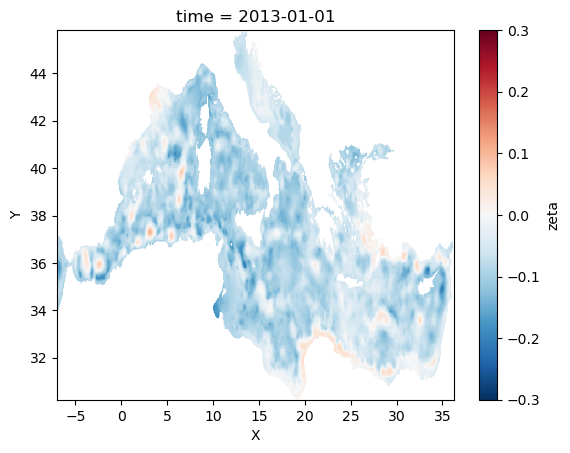
Compute geostrophic velocities from SLA
changement de coordonnes pour faire des gradients
[24]:
#on attribue des coordonnes en m pour calculer les gradients
sla2=sla.assign_coords({'X':ds3.xgrid[1,:],'Y':ds3.ygrid[:,1]})
[25]:
#sla_aviso=ds_aviso.sla
#sla_aviso=sla_aviso.compute()
#sla_aviso.mean('time').plot()
[26]:
#compute gradients
ugeos=-sla2.differentiate('Y')
vgeos=sla2.differentiate('X')
[27]:
#on rechange dans le sens initial pour avoir des coordonnes geographiques
ugeos=ugeos.assign_coords({'X':sla.X,'Y':sla.Y})
vgeos=vgeos.assign_coords({'X':sla.X,'Y':sla.Y})
on regrille le modele toute les 6h
[28]:
%%time
ugeos_croco=ugeos.resample(time="6H").mean()
vgeos_croco=vgeos.resample(time="6H").mean()
CPU times: user 19.3 s, sys: 4.28 s, total: 23.6 s
Wall time: 24 s
on multiplie par g/f pour avoir une vitesse geostrophique
[29]:
ugeos_croco*=-grav/ds3.f.data[np.newaxis,:,:]
vgeos_croco*=-grav/ds3.f.data[np.newaxis,:,:]
[30]:
ugeos_croco=ugeos_croco.where(ds3.mask==1)
vgeos_croco=vgeos_croco.where(ds3.mask==1)
[31]:
ugeos_croco.sel(time=tsl).plot(vmin=-0.5,vmax=0.5,cmap="bwr")
[31]:
<matplotlib.collections.QuadMesh at 0x2aaae7f13310>
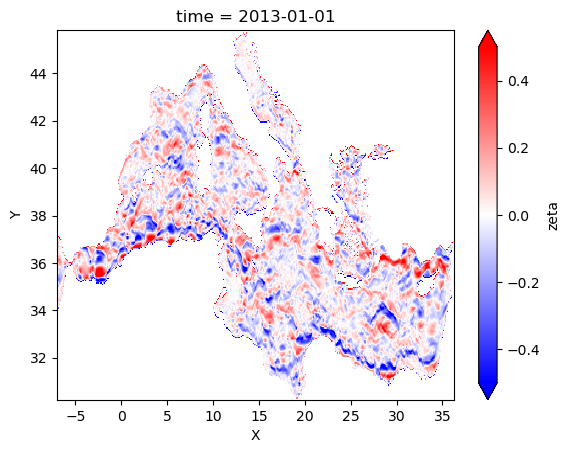
READ AVISO
[32]:
list_aviso=glob.glob('/home/shom_simuref/CROCO/ODC/DATA/ALTI/AVISO/201[2-3]/*.nc')
#read AVISO grid
ds_aviso_grd=xr.open_dataset(list_aviso[0])
dy_aviso,dx_aviso=area(ds_aviso_grd.latitude,ds_aviso_grd.longitude,return_grid=True)
get Croco time bounds
[33]:
time_bnds=slice(ugeos.time[0],ugeos.time[-1])
Load AVISO
[34]:
%%time
ch={"time":-1,"longitude":-1,"latitude":-1}
ds_aviso=xr.open_mfdataset(list_aviso,chunks=ch,
combine="by_coords",
data_vars='minimal', coords='minimal', compat='override')
ds_aviso=ds_aviso.chunk(ch)
CPU times: user 12.1 s, sys: 704 ms, total: 12.9 s
Wall time: 27.9 s
[35]:
#control plot
ds_aviso.ugosa.sel(time="2013-01-01").plot(cmap='bwr')
[35]:
<matplotlib.collections.QuadMesh at 0x2aad95d10460>
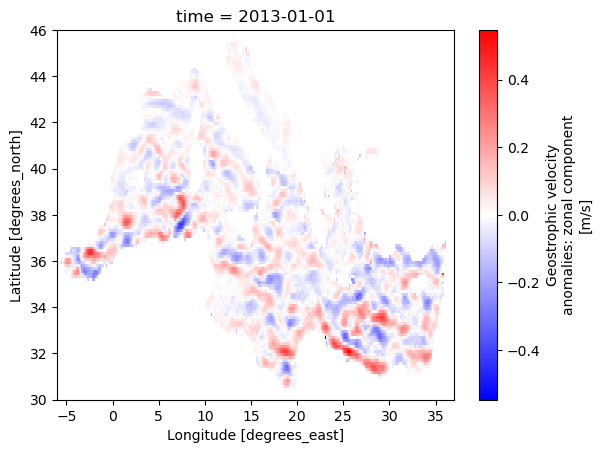
Select Aviso on the same time bounds that Croco
[36]:
ds_aviso=ds_aviso.sel(time=time_bnds)
Compute (load in memory here) Aviso
[37]:
%%time
ugeos_aviso=ds_aviso['ugosa'].compute()
vgeos_aviso=ds_aviso['vgosa'].compute()
CPU times: user 3.3 s, sys: 388 ms, total: 3.69 s
Wall time: 5.29 s
[58]:
#%%time
#zetamin=ds.zeta.min().compute()
#zetamax=ds.zeta.max().compute()
CPU times: user 12.9 s, sys: 0 ns, total: 12.9 s
Wall time: 4min 5s
Interp CROCO to aviso time
[38]:
%%time
ugeos_croco2=ugeos_croco.interp(time=ugeos_aviso.time.data,method="linear").compute()
vgeos_croco2=vgeos_croco.interp(time=ugeos_aviso.time.data,method="linear").compute()
CPU times: user 2.46 s, sys: 4.26 s, total: 6.72 s
Wall time: 6.82 s
[39]:
fig, ax = plt.subplots(figsize=(12, 4))
ugeos_croco.mean('time').plot(cmap=plt.cm.RdBu_r,ax=ax,vmin=-0.3,vmax=0.3)
[39]:
<matplotlib.collections.QuadMesh at 0x2aaaf2d7ed70>
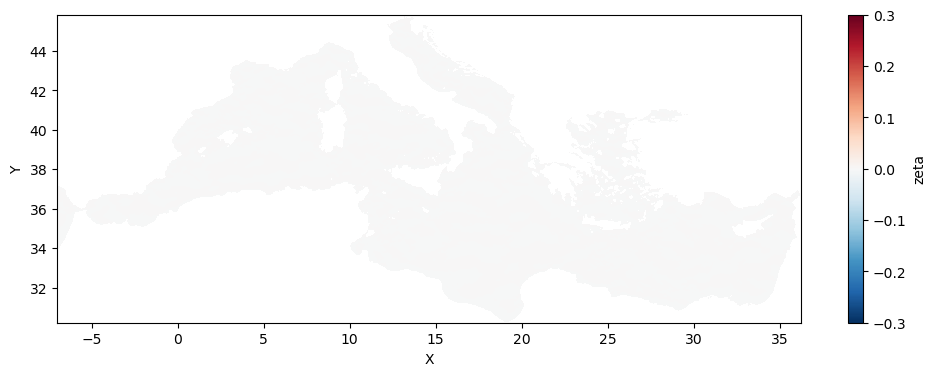
[46]:
fig, ax = plt.subplots(figsize=(12, 4))
pp=ugeos_aviso.mean('time').plot(ax=ax)
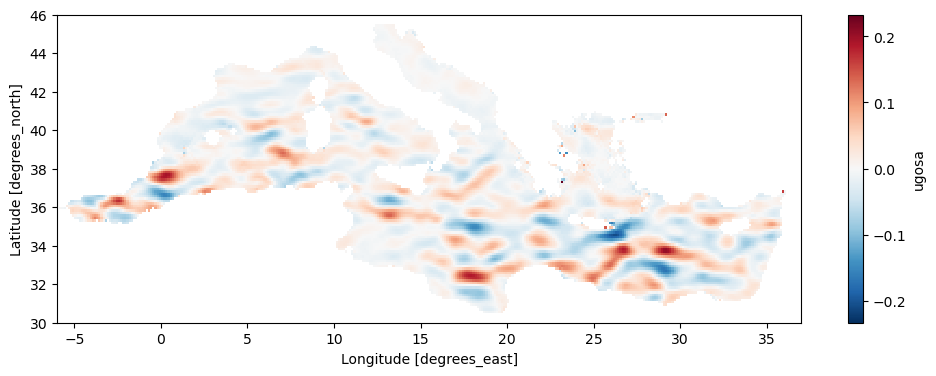
SET FILTERS FUNCTIONS
WRAPPER FOR SCIPY FUNCTION
[60]:
def butter_filt(x,order_butter,Tc,fs):
#data are in days so Tc must be in days
#TC in days = cut off frequency
# fs in days = sampling frequency of x
fc=2/Tc
b, a = signal.butter(order_butter, fc, 'low', fs=fs, output='ba')
# Check NA values
co = np.count_nonzero(~np.isnan(x))
#if co < 4: # If fewer than 4 observations return -9999
# return np.empty(x.shape)
#else:
return signal.filtfilt(b, a, x)
WRAPPER FOR XARRAY FUNCTION
[61]:
def filtfilt_butter(x,Tc,fs,order_butter,dim='time'):
# x ...... xr data array
# dims .... dimension aong which to apply function
filt= xr.apply_ufunc(
butter_filt, # first the function
x,# now arguments in the order expected by 'butter_filt'
order_butter, # argument 1
Tc, # arugment 2
fs, # argument 3
input_core_dims=[["time"], [], [],[]], # list with one entry per arg
output_core_dims=[["time"]], # returned data has 3 dimension
exclude_dims=set(("time",)), # dimensions allowed to change size. Must be a set!
vectorize=True, # loop over non-core dims
dask="parallelized",
output_dtypes=[x.dtype],
)
return filt
PARAMETERS OF THE FILTER
[62]:
Tc=100 #frequence de coupure en jours
fs=1 #periode d'échantillonage en jours
order_butter=4
Function that return filetered components
[63]:
def get_filtered(u,v):
u_low=filtfilt_butter(u,Tc,fs,order_butter,dim="time")
v_low=filtfilt_butter(v,Tc,fs,order_butter,dim="time")
u_low['time']=u.time
v_low['time']=v.time
u_low=u_low.transpose(*u.dims)
v_low=v_low.transpose(*v.dims)
u_high=u-u_low
v_high=v-v_low
return u_low,v_low,u_high,v_high
[64]:
%%time
u_aviso_l,v_aviso_l,u_aviso_h,v_aviso_h=get_filtered(ugeos_aviso,vgeos_aviso)
u_croco_l,v_croco_l,u_croco_h,v_croco_h=get_filtered(ugeos_croco2,vgeos_croco2)
CPU times: user 4min 32s, sys: 3.48 s, total: 4min 35s
Wall time: 4min 38s
Function that compute Eke from U,V
EKE=g2/4f2 * (u’2+v’2) le g/f est déjà dans les composantes U’ et V’
[65]:
# en cm.s-1 pour comparer avec rapport Adetoc (le 0.5 est une erreur mais present dans les figures du rapport)
def get_eke(u_l,v_l,u_h,v_h):
eke_l=100*N.sqrt(0.5*(u_l**2+v_l**2))
eke_h=100*N.sqrt(0.5*(u_h**2+v_h**2))
return eke_l,eke_h
# en m2.s-2
#def get_eke(u_l,v_l,u_h,v_h):
# eke_l=u_l**2+v_l**2
# eke_h=u_h**2+v_h**2
# return eke_l,eke_h
[66]:
#EKE low et high
eke_aviso_l,eke_aviso_h=get_eke(u_aviso_l,v_aviso_l,u_aviso_h,v_aviso_h)
eke_croco_l,eke_croco_h=get_eke(u_croco_l,v_croco_l,u_croco_h,v_croco_h)
[67]:
#EKE global (low+high)
#en cm.s-1
eke_croco=100*N.sqrt(0.5*(ugeos_croco2**2+vgeos_croco2**2))
eke_aviso=100*N.sqrt(0.5*(ugeos_aviso**2+vgeos_aviso**2))
#en m2.s-2
#eke_croco=N.sqrt(ugeos_croco2**2+vgeos_croco2**2)
#eke_aviso=N.sqrt(ugeos_aviso**2+vgeos_aviso**2)
[68]:
#%%time
#ugeos_low=filtfilt_butter(ugeos_aviso,Tc,fs,order_butter,dim="time")
#ugeos_high=ugeos-ugeos_low
#ugeos_low[100,100,:].plot()
#sans apply_ufunc
#test2=butter_filt(ugeos_aviso[:,100,100],order_butter,Tc,fs)
#plt.plot(test2)
PLOTS
[69]:
def get_minmax(aviso,croco):
print("croco",croco.min().data,croco.max().data)
print("aviso",aviso.min().data,aviso.max().data)
[70]:
get_minmax(eke_aviso,eke_croco)
croco 0.000847563383380055 558.5315217244956
aviso 0.0 91.00112636665548
[71]:
import matplotlib.colors as colors
norm=colors.LogNorm(vmin=1e-4,vmax=5e-2)
norm=colors.LogNorm(vmin=1e-2,vmax=50)
CONTROL PLOTS WITHOUT CARTOPY
[72]:
eke_aviso_l.mean('time').plot(cmap=plt.cm.gist_rainbow_r,norm=norm)
[72]:
<matplotlib.collections.QuadMesh at 0x2aade015e830>
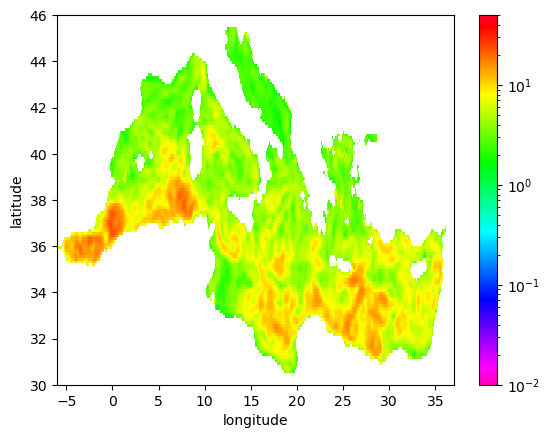
[73]:
eke_croco_l.mean('time').plot.pcolormesh(cmap=plt.cm.gist_rainbow_r,norm=norm)
[73]:
<matplotlib.collections.QuadMesh at 0x2aade09c6920>
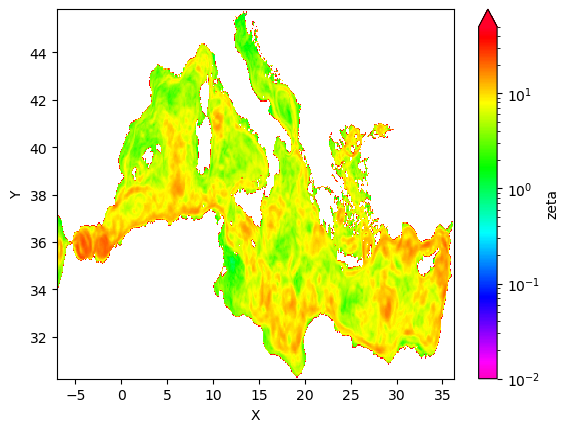
SET PROJECTIONS TO USE CARTOPY
[74]:
import cartopy.crs as ccrs
from cartopy.feature import ShapelyFeature
import cartopy.feature as cfeature
[75]:
proj=ccrs.LambertConformal(central_latitude=38,central_longitude=15)
lon=eke_aviso_l.longitude
lat=eke_aviso_l.latitude
kw_cb=dict(extend="neither")
GENERIC FUNCTION TO PLOT THE DATA
[76]:
def plot_data(lon,lat,data,ax,name,filt,season,**kwargs_plot):
#fig,ax=plt.subplots(1,1,figsize=(10,8),subplot_kw=dict(projection=proj))
ax.set_extent([-7,36,30,45],crs=ccrs.PlateCarree())
ax.coastlines()
ax.add_feature(cfeature.LAND, zorder=1, edgecolor='k')
ax.set_title(f'{name} - {season} mean')
cf=ax.pcolormesh(lon,lat,data,**kwargs_plot)
#plt.savefig(f'EKE_{name}_{filt}_{season}.png')
#cbar
return ax,cf
[77]:
datas=['aviso','croco']
filters=['low','high']
seasons=["DJF", "MAM", "JJA", "SON"]
GENERIC FUNCTION TO PLOT ALL SEASONS IN ONE PLOT GIVEN FREQUENCY
[146]:
def make_figure(aviso,croco,filt,vmin,vmax):
norm=colors.LogNorm(vmin=vmin,vmax=vmax)
kwargs_plot=dict(norm=norm,transform=ccrs.PlateCarree(),cmap=plt.cm.gist_ncar)
fig, axes = plt.subplots(nrows=5, ncols=2, figsize=(14, 12),subplot_kw=dict(projection=proj))
plt.suptitle(f'EKE {filt} Freq (cutoff={Tc} days) {date_start}->{date_end}')
for i, season in enumerate(("YEAR","DJF", "MAM", "JJA", "SON")):
#print(season)
data1=aviso
data2=croco
if (season=="YEAR"):
data1=data1.mean('time')
data2=data2.mean('time')
else:
data1=data1.groupby('time.season').mean('time').sel(season=season)
data2=data2.groupby('time.season').mean('time').sel(season=season)
ax,cf=plot_data(data1.longitude,data1.latitude,data1,axes[i,0],"aviso",filt,season,**kwargs_plot)
ax,cf=plot_data(data2.X,data2.Y,data2,axes[i,1],"croco",filt,season,**kwargs_plot)
#cbar = fig.colorbar(cf, ax=axes.ravel().tolist(), shrink=0.7,label='$m^2$.$s^-2$')
cbar = fig.colorbar(cf, ax=axes.ravel().tolist(), shrink=0.7,label='$cm$.$s^-1$')
return fig
[147]:
get_minmax(eke_aviso_l,eke_croco_l)
croco 0.0006029959162151201 192.3656099789513
aviso 0.002228543022646149 52.36813484043892
[148]:
#fig_low=make_figure(eke_aviso_l,eke_croco_l,"low",1e-4,1e-1)
fig_low=make_figure(eke_aviso_l,eke_croco_l,"low",1,50)
fig_low.savefig('eke_low_pass.png')
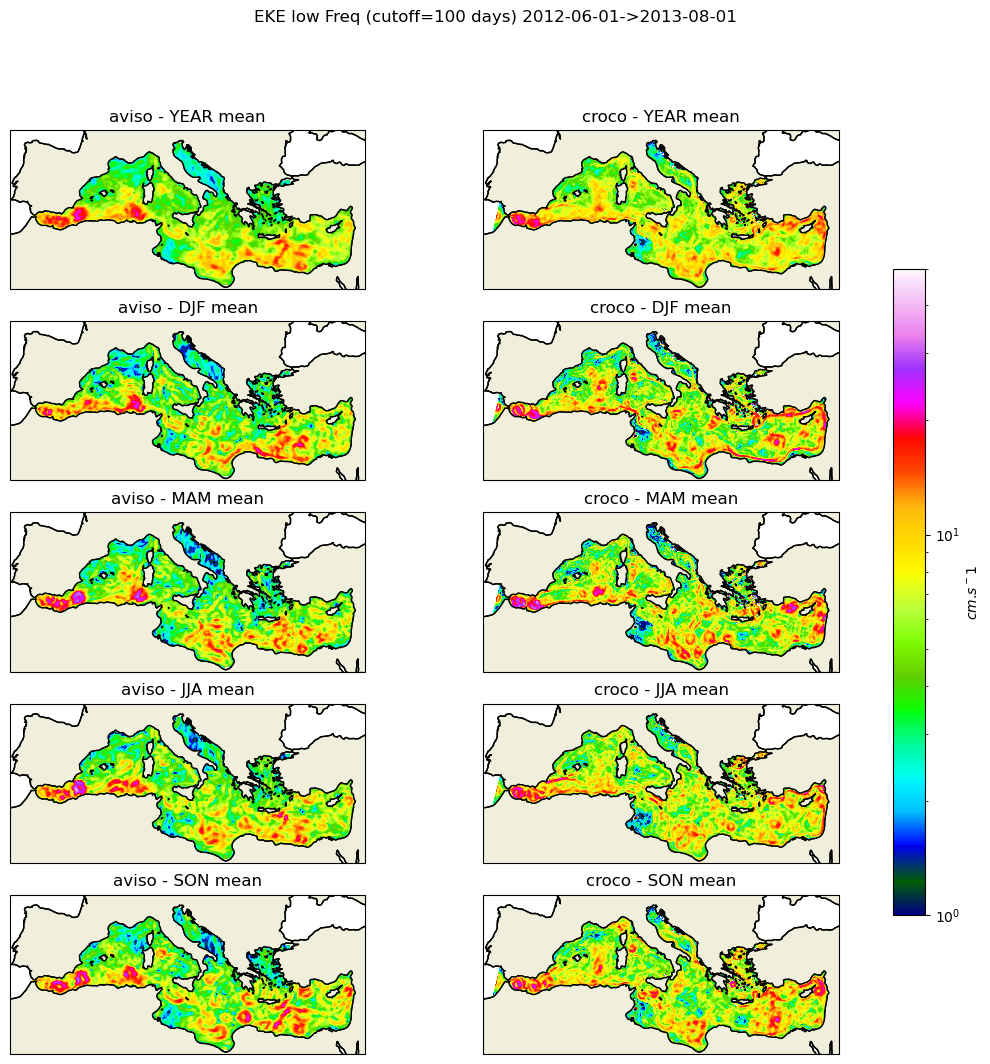
[149]:
get_minmax(eke_aviso_h,eke_croco_h)
croco 8.079912308416298e-05 453.0415986678146
aviso 0.001477820265338066 37.14392102696245
[150]:
#fig_high=make_figure(eke_aviso_h,eke_croco_h,"high",1e-4,5e-1)
fig_high=make_figure(eke_aviso_h,eke_croco_h,"high",1,100)
fig_high.savefig('eke_high_pass.png')

[151]:
get_minmax(eke_aviso,eke_croco)
croco 0.000847563383380055 558.5315217244956
aviso 0.0 91.00112636665548
[152]:
#fig_all=make_figure(eke_aviso,eke_croco,"all",1e-4,5e-1)
fig_all=make_figure(eke_aviso,eke_croco,"all",1,100)
fig_all.savefig('eke_all_pass.png')

PLOT BY BASINS
Read shapefile
[153]:
basins_shp='/home/shom_simuref/CROCO/ODC/POSTPROC/DATA/shapefiles/med_sub_basins_2.shp'
[154]:
### read basins shape
[155]:
shp=shpreader.Reader(basins_shp)
shape_feature = ShapelyFeature(shp.geometries(),
ccrs.PlateCarree(),facecolor=None)
[156]:
gdf=gpd.read_file(basins_shp)
gdf.plot()
[156]:
<AxesSubplot: >
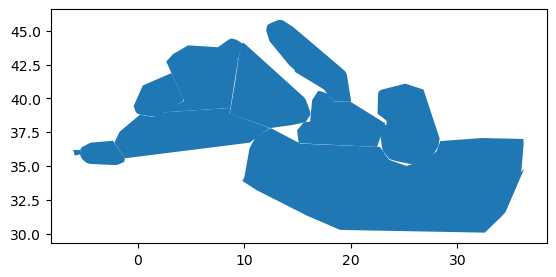
Get basins list
[157]:
gdf=gdf.set_index('name')
basins_names=gdf.index
[158]:
print(basins_names)
Index(['Strait of Gibraltar', 'Alboran Sea', 'Ionian Sea', 'Tyrrhenian Sea',
'Adriatic Sea', 'Levantine Sea', 'Aegean Sea', 'Balearic Sea',
'South-Western Basin', 'North-Western Basin'],
dtype='object', name='name')
Get grid from Croco and Aviso
[134]:
lon,lat=eke_aviso.longitude,eke_aviso.latitude
lon_aviso,lat_aviso=N.meshgrid(lon,lat)
lon,lat=eke_croco.X,eke_croco.Y
lon_croco,lat_croco=N.meshgrid(lon,lat)
Transpose data to have uniform data
[135]:
eke_aviso_l=eke_aviso_l.transpose("time","latitude","longitude")
eke_aviso_h=eke_aviso_h.transpose("time","latitude","longitude")
eke_croco_l=eke_croco_l.transpose("time","Y","X")
eke_croco_h=eke_croco_h.transpose("time","Y","X")
[136]:
name='Levantine Sea'
#select area of interest
area=gdf.loc[gdf.index==name]
mask_aviso=shapely.vectorized.contains(area.dissolve().geometry.item(),lon_aviso,lat_aviso)
mask_croco=shapely.vectorized.contains(area.dissolve().geometry.item(),lon_croco,lat_croco)
[137]:
eke_aviso_area=eke_aviso_l.where(mask_aviso)
eke_aviso_area2=eke_aviso_area.copy()
#eke_aviso_area2[:]=N.sqrt(eke_aviso_area.data)
[138]:
#eke_aviso_area2[:]*=100.
eke_aviso_area2.mean(dim=["latitude","longitude"]).plot()
[138]:
[<matplotlib.lines.Line2D at 0x2aade27f0940>]
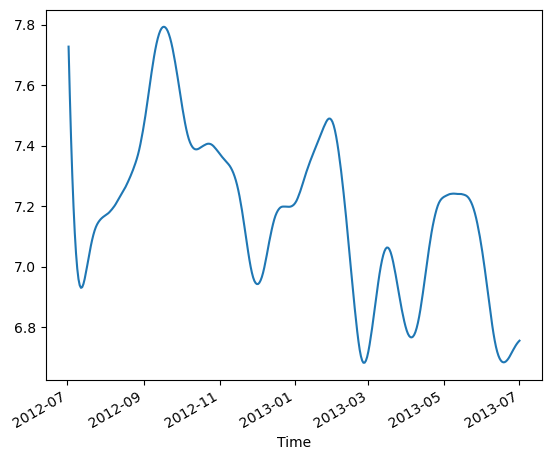
Function to format Data
[139]:
def format_date(ax):
return ax.xaxis.set_major_formatter(
mdates.ConciseDateFormatter(ax.xaxis.get_major_locator()))
Function to plot by frequency
[165]:
def plot_all(aviso,croco,freq):
basins_names2=basins_names.tolist()[:]
#fig, axes = plt.subplots(nrows=len(basins_names2), sharex=True,sharey=False,ncols=1, figsize=(12, 12))
fig, axes = plt.subplots(nrows=5,ncols=2, sharex=True,sharey=False, figsize=(12, 12))
for i,name in enumerate(basins_names2):
print(i,name)
#select area of interest
area=gdf.loc[gdf.index==name]
#get the mask from longitude and latitude : intersection of area and the domain
mask_aviso=shapely.vectorized.contains(area.dissolve().geometry.item(),lon_aviso,lat_aviso)
mask_croco=shapely.vectorized.contains(area.dissolve().geometry.item(),lon_croco,lat_croco)
#apply the mask to the data and do an average over the horizontal grid
eke_aviso_area=aviso.where(mask_aviso).mean(dim=["latitude","longitude"])
eke_croco_area=croco.where(mask_croco).mean(dim=["X","Y"])
#ax=axes[i]
ax=axes.flatten()[i]
#do the plot
ax.plot(eke_aviso_area.time,eke_aviso_area.data,label="Aviso")
ax.plot(eke_croco_area.time,eke_croco_area.data,label="Croco")
### custom labels ###
plt.xlabel('');plt.ylabel('')
#get min,max to set clean limits
min1,max1=eke_aviso_area.data.min(),eke_aviso_area.data.max()
#min2,max2=eke_aviso_area.data.min(),eke_aviso_area.data.max()
min2,max2=eke_croco_area.min(),eke_croco_area.max()
if i == 0:
ax.legend()
#ax.set_ylabel('$m^2$.$s^-2$')
ax.set_ylabel('$cm$.$s^-1$')
ax.set_title('%s'%(name))
ax.set_ylim((min(min1,min2),max(max1,max2)))
ax.yaxis.set_minor_locator(MaxNLocator(1))
if i==len(basins_names2)-1:
ax=format_date(ax)
plt.suptitle(f'EKE {freq} - Cutoff={Tc} days')
plt.tight_layout()
return fig
[166]:
fig_ts_low=plot_all(eke_aviso_l,eke_croco_l,"low")
0 Strait of Gibraltar
1 Alboran Sea
2 Ionian Sea
3 Tyrrhenian Sea
4 Adriatic Sea
5 Levantine Sea
6 Aegean Sea
7 Balearic Sea
8 South-Western Basin
9 North-Western Basin
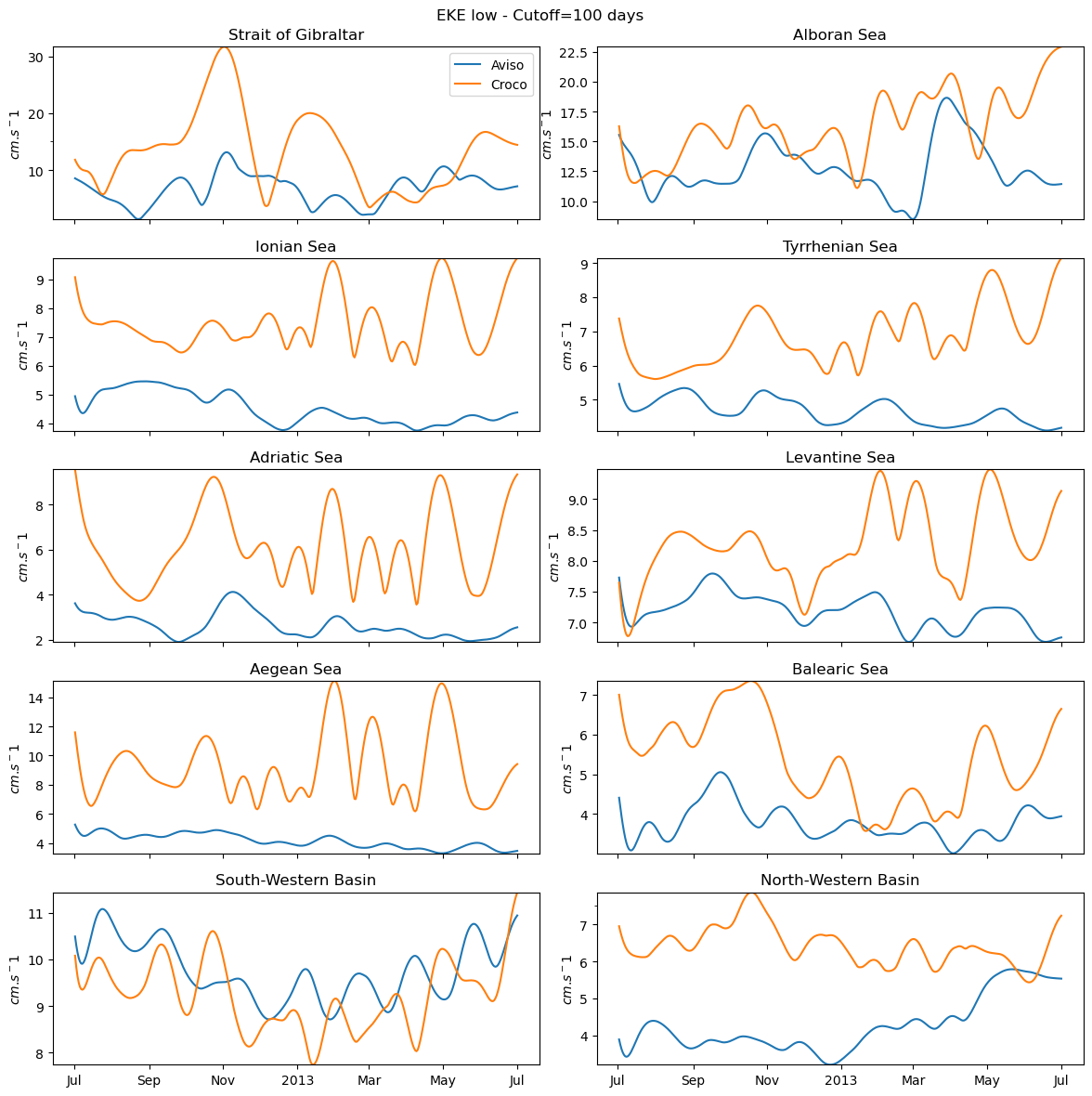
[167]:
fig_ts_low.savefig('eke_time_serie_low_pass.png')
[168]:
fig_ts_high=plot_all(eke_aviso_h,eke_croco_h,"high")
0 Strait of Gibraltar
1 Alboran Sea
2 Ionian Sea
3 Tyrrhenian Sea
4 Adriatic Sea
5 Levantine Sea
6 Aegean Sea
7 Balearic Sea
8 South-Western Basin
9 North-Western Basin

[169]:
fig_ts_high.savefig('eke_time_serie_high_pass.png')
[170]:
fig_ts_all=plot_all(eke_aviso,eke_croco,"all")
fig_ts_all.savefig('eke_time_serie_all_pass.png')
0 Strait of Gibraltar
1 Alboran Sea
2 Ionian Sea
3 Tyrrhenian Sea
4 Adriatic Sea
5 Levantine Sea
6 Aegean Sea
7 Balearic Sea
8 South-Western Basin
9 North-Western Basin

[ ]: